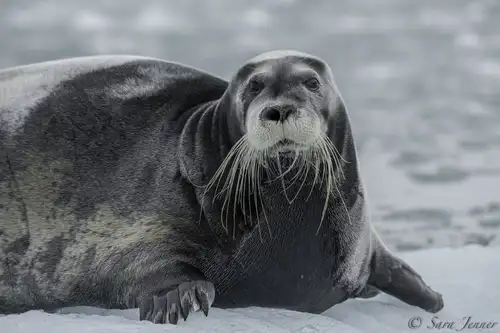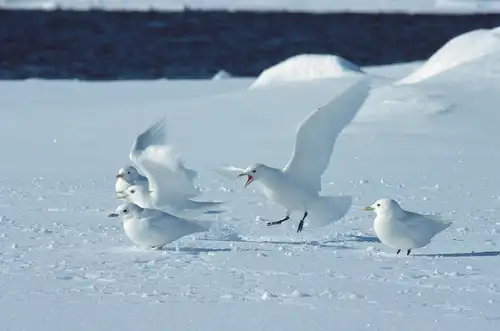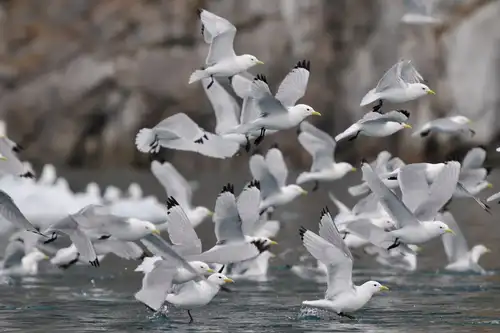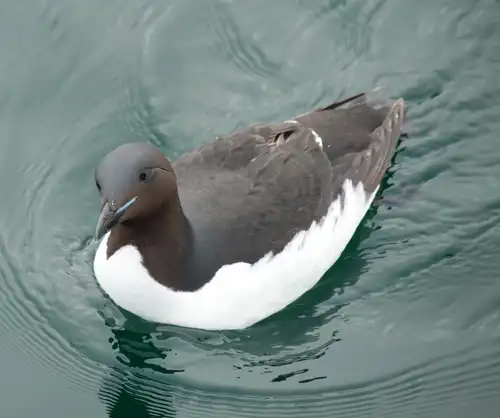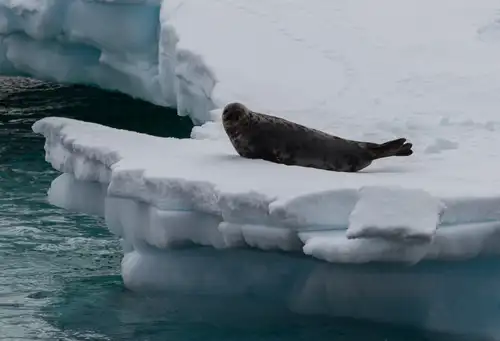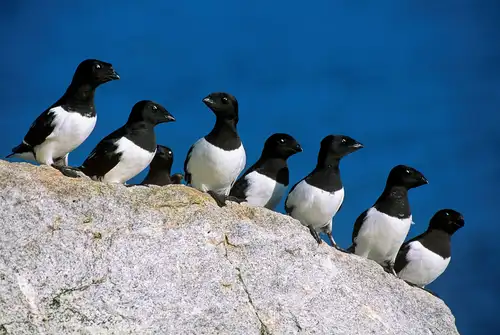



















 20 Days/19 Nights
20 Days/19 Nights
You arrive in Longyearbyen, the main town of Spitsbergen. Explore this former mining town with its church and Svalbard Museum. In the evening, the ship sails out of Isfjorden, possibly spotting a minke whale. You head to Trygghamna to see old whaling and hunting station remains.
Foxes, seabirds, and reindeer
From Trygghamna, walk to Alkhornet, a seabird cliff. Look for Arctic foxes and grazing reindeer below the cliffs.
Fuglefjorden to Raudfjorden
Sail into Fuglefjorden with views of Svitjodbreen and Birgerbukta, home to great skuas and possibly polar bears. Raudfjorden offers glacier views and is a habitat for seals, seabirds, and sometimes polar bears and beluga whales.
Onward to East Greenland
Watch for whales and migrating seabirds as you approach the east Greenland sea ice.
Remains of the trappers
Arrive at Foster Bay and land at Myggbukta. Explore the tundra with musk oxen and geese near an old hunters’ hut.
Bright bergs, big mountains
Sail through Kaiser Franz Josef Fjord, enjoying mountains and icebergs. Reach Teufelsschloss, a mountain with unique geology.
The essential Arctic
Land at Blomsterbugten to spot Arctic hare and musk oxen. Explore Noah Lake and hike in Kaiser Franz Joseph Fjord, surrounded by icebergs and Arctic scenery.
Into the Antarctic Sound
Land in Renbugten to search for musk oxen and Arctic hares. Sail east into Antarctic Sound, reaching Maria Island by nightfall.
Meeting Menander
Enter Kong Oscars Fjord and attempt a landing near Menander Øer for walking opportunities.
Colors of Arctic autumn
Land in Antarctic Havn, an expansive valley with musk oxen and colorful vegetation. Learn about the area's geopolitics from the 1930s.
Sailing to Scoresbysund
Sail towards Scoresbysund, the largest fjord system in the world.
Inuit neighborhood of yesteryear
Reach Scoresbysund and sail along Volquart Boons Kyst. Take a Zodiac cruise past glacier fronts and visit Danmark Island to see an old Inuit settlement.
Nordvestfjord’s enormous icebergs
Land near Sydkap to see Arctic hares. Sail into Nordvestfjord, encountering massive icebergs.
The tundra of Jameson Land
Explore the tundra of Jameson Land with grazing musk oxen. Possible landings include Tyskit Nunat, Kap Hooker, or a lagoon near Kap Stewart.
Settlement at Scoresbysund
Visit Ittoqqortoormiit, the largest settlement in Scoresbysund. Buy stamps at the post office or explore the town.
The hikes of Hurry Inlet
Stop at a lagoon near Kap Stewart to see waders and geese. Hike near the head of Hurry Inlet fjord and possibly climb J.P. Koch Fjeld. Spend the night anchored off Constable Pynt.
Final call at Constable Pynt
Take a chartered plane from Constable Pynt to Keflavik, bringing home lasting memories.














s/v Remvrandt van Rijin
Our three-mast schooner, Rembrandt van Rijn, is ideally suited for expedition cruising among the fjords of Greenland and Spitsbergen.
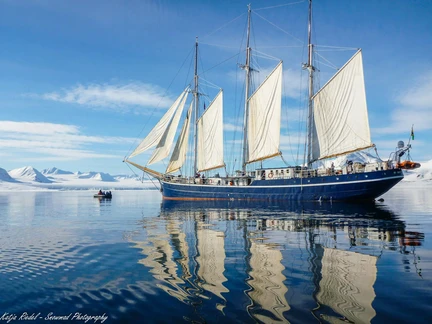
Specifications
| Passengers: | 33 in 16 cabins |
| Staff & crew: | Crew 10 | Guides 2 |
| Length: | 49,50 meters |
| Breadth: | 6,65 meters (22,9 ft) |
| Draft: | 2,8 meters (8 ft) |
| Ice class: | Suitable to sail in the Svalbard and Greenlandic waters. |
| Displacement: | 435 tonnes |
| Propulsion: | 2 cummins engines together 550 KW |
| Speed: | 6,5 knots average cruising speed |
Cabins Gallery


Ship Interior Gallery


Ship Exterior Gallery


S/V Rembrandt Van Rijn was originally built as a herring lugger in 1947. The vessel was then rebuilt as a three-mast passenger sailing schooner in he Netherlands in 1994, sailing in Spitsbergen (1994 – 1996) and the Galápagos (1998 - 2001). The vessel later underwent a complete rebuilding and refurbishment program until 2011. The communication and navigation equipment has been completely renewed according to the latest SOLAS regulations.
Perfect for expedition cruising among small islands
The ship is well suited for expedition cruising among small islands and offer good open deck viewing areas, also when under sail. The two inflatable rubber crafts (Zodiacs) enable landing and wildlife viewing opportunities in otherwise inaccessible areas.
Comfort and Character
Rembrandt van Rijn measures 49,50 meters in length, 7 meters in width, and has a draft of 2,8 meters. The average cruising speed on engines is 6,5 knots. It has an experienced crew of 12 persons on board including 2 tour guides. The ship can accommodate a maximum of 33 passengers in 16 cabins. It has one Triple Private cabin (with shower and toilet and porthole), six Twin Private Inside cabins (with shower and toilet, no porthole), and nine Twin Private cabins (with shower and toilet and porthole).
Age range & Nationality onboard
Passengers on a typical voyage range from their 30s to their 80s - with a majority usually from 45 - 65, but a little younger on the Rembrandt van Rijn, between 30 - 55. Our expeditions attract independent-minded travellers from around the world. They are characterised by a strong interest in exploring remote regions. The camaraderie and spirit that develops aboard is an important part of the expedition experience. Many departures have several nationalities on board.
Catering
Three simple but good meals of international cuisine per day are served buffet style in the restaurant and is prepared by our cook.
Dress code
In keeping with our expeditions atmosphere, dress on board is informal. Bring casual and comfortable clothing for all activities. Keep in mind that much of the spectacular scenery can be appreciated from the deck, which can be slippery. Bring sturdy shoes with no-slip soles and make sure the parka is never far away in case of the call "Whales!" comes over the loudspeaker and you have to dash outside. Wear layers since it is comfortably warm aboard the ship - and often cold on deck.
Electric Current
The electrical supply aboard the ship is 220 volt 50hz. Electrical outlets are standard European with two thick round pins. U.S. passengers may need a 220v/110v converter.
Excursions & Landings
Every day there will be excursions on land, weather and ice permitting. The landings will take three to six hours per day over untracked areas. According to circumstances (the weather, the ice situation or the passengers´ wishes) the program can sometimes be adjusted. Ample time will be devoted to wildlife, vegetation, geography, and history.
Gratuities
The customary gratuity to the ship's crew and expedition leader is made as a blanket contribution at the end of the voyage. Tipping is a very personal matter and the amount you wish to give is at your discretion. We suggest to give cash in Euros, US Dollars or Danish kroner.
Non-smoking policy
On board our vessels we have a non-smoking policy. It is prohibited to smoke inside the ship. You can smoke in designated ares. Please respect the wishes of non-smokers.
The crew
The crew of the ´Rembrandt van Rijn´ consists of 9 experienced crew and 2 expedition guides and a cook. The sailors are in charge during sailing and will bring us ashore.
Your physical condition
You must be in good general health and you should be able to walk several hours per day. The expedition is ship-based and physically not very demanding. Although we spend as much time as possible ashore, you are welcome to remain aboard the ship if you like. To join most excursions, you must be able to get up and down the ladder from the ship to the water level to board the Zodiacs. Staff will assist you in and out of the boats. This will become progressively easier with practice. Ashore it can be slippery and rocky. You are travelling in remote areas without access to sophisticated medical facilities, so you must not join this expedition if you have a life-threatening condition, or need daily medical treatment.
- Expeditions cruises are trips that focus on maximum contact with local wildlife, natural phenomena, and locations of cultural/scientific significance. These trips are best enjoyed in relatively small groups led by highly experienced expedition guides.
- Our passengers range from their 30s to their 80s, with the majority being between 45 and 65 years old. On our sailing vessels, passengers tend to be slightly younger. Our expeditions usually attract independent travelers from around the world who are characterized by a strong interest in exploring remote regions. The camaraderie and spirit of adventure that develops between our passengers is an important part of the expedition experience.
- No, you are not able to change currency on board.
- Aboard Hondius, Ortelius, Plancius, and Rembrandt van Rijn, refreshments and souvenirs will be charged to your cabin. The day before disembarking, you can settle your bill with the hotel manager and pay by Visa or MasterCard, Diners Club/Discover, Union Pay, or cash (Euro or USD). The prices and standard currency on board all of our vessels is the Euro.
- Greenland is the world's biggest island stretching approximately 2800 kilometres (1750 miles) from north to south. 85% of Greenland is covered in ice and is therefore white on the map.
- Greenland uses Coordinated Universal Time (UTC), with a range of UTC +0 to -4. This means that if it is 18:00 UTC (6 p.m.) in Nuuk when you travel to Greenland, it would be 16:00 (4 p.m.) in New York City, USA, 21:00 (9 p.m.) in London, U.K. and 09:00 (9 a.m.) the next morning in the Antarctic South Pole.
- There are in total 16 cabins at the Rembrandt van Rijn: 1 triple Private cabin with porthole (with shower and toilet). 6 twin private inside cabins (with shower and toilet, no porthole). 9 twin cabins (with shower and toilet and porthole) .
- Our sailing vessels are operated by experienced captains and crew. Passengers are invited to help with the sailing process under crew supervision.
You May Also Like



Alpine Peaks of Spitsbergen, Ski & Sail
 8 Days / 7 Nights
8 Days / 7 Nights

Arctic Ocean - Fair Isle, Jan Mayen, Ice Edge, Spitsbergen, Birding
 10 Days / 9 Nights
10 Days / 9 Nights
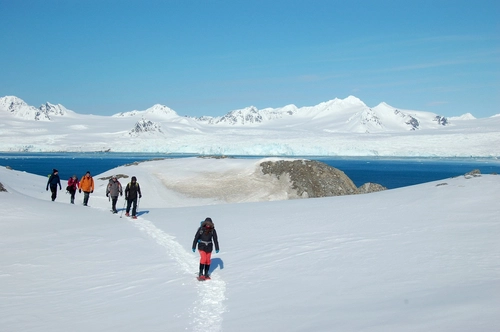
North Spitsbergen - Arctic Spring , Hike & Sail
 8 Days / 7 Nights
8 Days / 7 Nights

North Spitsbergen Explorer - Into the pack ice - Polar Bear Special
 8 Days / 7 Nights
8 Days / 7 Nights

Arctic Ocean - Jan Mayen, Ice edge, Spitsbergen, Birding
 9 Days / 8 Nights
9 Days / 8 Nights

Arctic Ocean - Fair Isle, Jan Mayen, Ice edge, Spitsbergen, Birding - Summer Solstice
 10 Days / 9 Nights
10 Days / 9 Nights

North Spitsbergen Explorer - Versatile landscapes, sea ice & wildlife
 8 Days / 7 Nights
8 Days / 7 Nights

North Spitsbergen Basecamp – Summer Solstice - Free Kayaking, Hiking, Photo Workshop, Diving (supplemented)
 8 Days / 7 Nights
8 Days / 7 Nights

North Spitsbergen Explorer - Versatile landscapes, sea ice & wildlife - Summer Solstice
 8 Days / 7 Nights
8 Days / 7 Nights

North Spitsbergen - Arctic Summer
 11 Days / 10 Nights
11 Days / 10 Nights

East Spitsbergen - Home of the Polar Bear, Including Long Hikes & Cleaning the Shores
 8 Days / 7 Nights
8 Days / 7 Nights

Around Spitsbergen, In the realm of Polar Bear & Ice
 10 Days / 9 Nights
10 Days / 9 Nights

North Spitsbergen Explorer – Into the Pack Ice – Polar Bear & Whale Special
 10 Days / 9 Nights
10 Days / 9 Nights

Northeast Greenland Solar Eclipse Explorer Voyage
 14 Days / 13 Nights
14 Days / 13 Nights

Spitsbergen - Northeast Greenland, Fly & Sail
 20 Days / 19 Nights
20 Days / 19 Nights
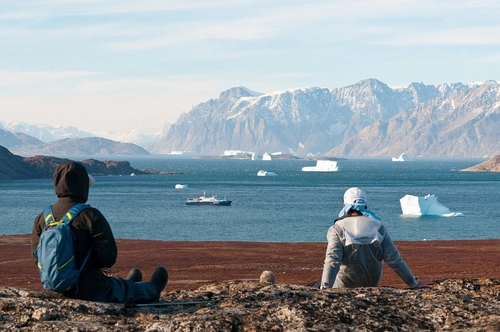
Northeast Greenland Extreme
 14 Days / 13 Nights
14 Days / 13 Nights

East Greenland, Scoresby Sund, Including Long Hikes
 10 Days / 9 Nights
10 Days / 9 Nights

Around Spitsbergen incl. Nordaustlandet
 10 Days / 9 Nights
10 Days / 9 Nights

East Greenland, Scoresby Sund - Aurora Borealis, Fly & Sail
 11 Days / 10 Nights
11 Days / 10 Nights

East Greenland, Scoresby Sund - Iceland , Aurora Borealis, Fly & Sail
 12 Days / 11 Nights
12 Days / 11 Nights

Alpine Peaks of Spitsbergen - Ski & Sail
 8 Days / 7 Nights
8 Days / 7 Nights

Arctic Ocean - Fair Isle, Jan Mayen, Ice Edge, Spitsbergen, Birding Special
 10 Days / 9 Nights
10 Days / 9 Nights

North Spitsbergen Explorer - Versatile Landscapes, Sea Ice & Wildlife
 8 Days / 7 Nights
8 Days / 7 Nights

North Spitsbergen Explorer - Into the Pack Ice - Polar Bear Special
 8 Days / 7 Nights
8 Days / 7 Nights

North Spitsbergen, Arctic Summer - Summer Solstice
 11 Days / 10 Nights
11 Days / 10 Nights

North Spitsbergen Explorer - Versatile Landscapes, Sea Ice & Wildlife - Summer Solstice
 8 Days / 7 Nights
8 Days / 7 Nights

North Spitsbergen Explorer - Into the Pack Ice - Polar Bear Special - Summer Solstice
 8 Days / 7 Nights
8 Days / 7 Nights

Arctic Ocean - Spitsbergen: Jan Mayen, Ice Edge & Birding - Summer Solstice
 9 Days / 8 Nights
9 Days / 8 Nights

North Spitsbergen Basecamp - Free kayaking, Hiking, Photo Workshop
 8 Days / 7 Nights
8 Days / 7 Nights

North Spitsbergen, Arctic Summer
 11 Days / 10 Nights
11 Days / 10 Nights

Around Spitsbergen, in the Icy Realm of the Polar Bear
 10 Days / 9 Nights
10 Days / 9 Nights

A Taste of North Spitsbergen - Compact Arctic Adventure
 6 Days / 5 Nights
6 Days / 5 Nights

South Spitsbergen Explorer - Bear Island - Diving (supplemented)
 10 Days / 9 Nights
10 Days / 9 Nights

Around Spitsbergen - Arctic Summer
 15 Days / 14 Nights
15 Days / 14 Nights

Around Spitsbergen and Nordaustlandet, In the Icy Realm of the Polar Bear
 10 Days / 9 Nights
10 Days / 9 Nights

Spitsbergen, Northeast Greenland & Scoresby Sund, Including Long Hikes
 14 Days / 13 Nights
14 Days / 13 Nights

South Spitsbergen, Bear Island & Mainland Norway - Aurora Borealis
 6 Days / 5 Nights
6 Days / 5 Nights

Six Seal Species You Might See On Your Greenland Cruise

Greenlandic Inuit Beliefs

Northeast Greenland National Park

Kayaking In Greenland

Tracking Greenland’s Wildlife from Space

Arctic and Antarctic Basecamp Cruises – Choose Your Own Adventure

Ice streams and lakes under the Greenland Ice Sheet

Scoresby Sund: the Greatest Greenland Adventure

Arctic Flowers, Trees, and Other Plant Life

5 Misconceptions You Might Have About Greenland
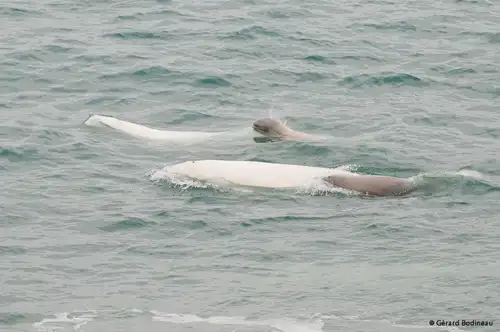
The Mysteries of the Beluga Whale

Narwhals: the Aquatic Unicorns of the Arctic

The World Is Changing for Greenland's Native Inuit People

Arctic on Foot: Hiking and Snowshoeing the Far North

10 Tips for Photographing the Northern Lights

Under the Greenland Ice Sheet
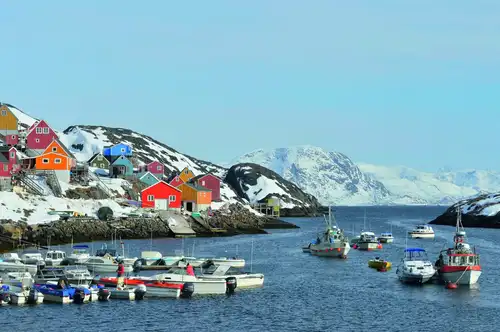
Amazing Greenland

Discover the Scoresby Sund Fjord System in East Greenland

The Northern Lights dancing across the skies



































